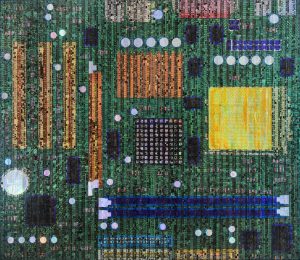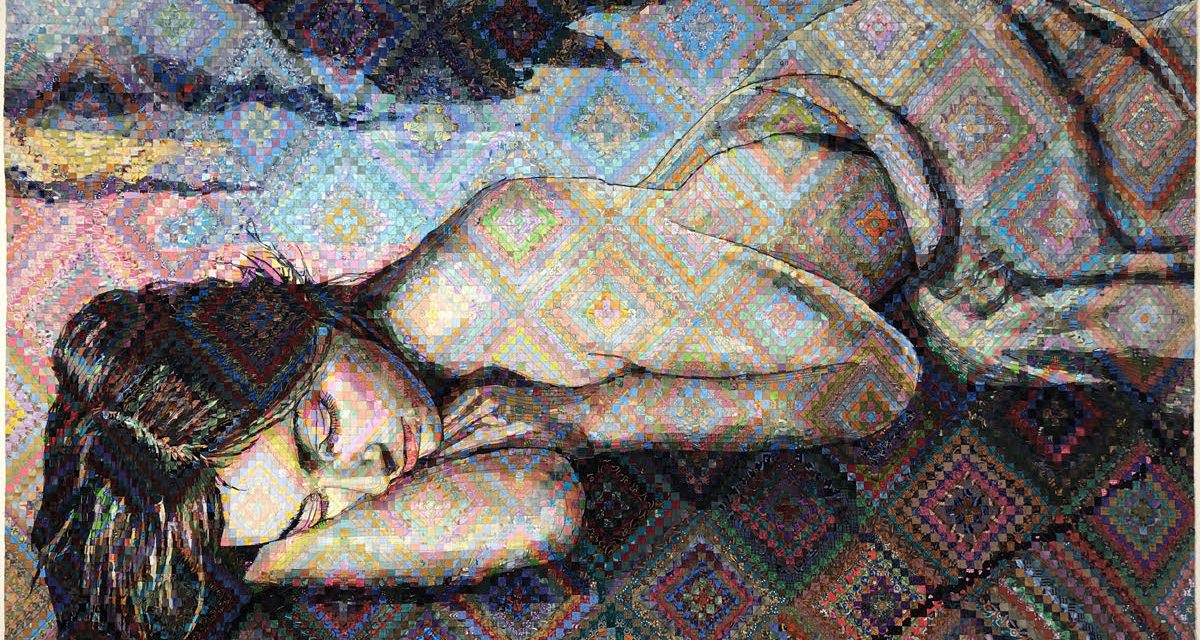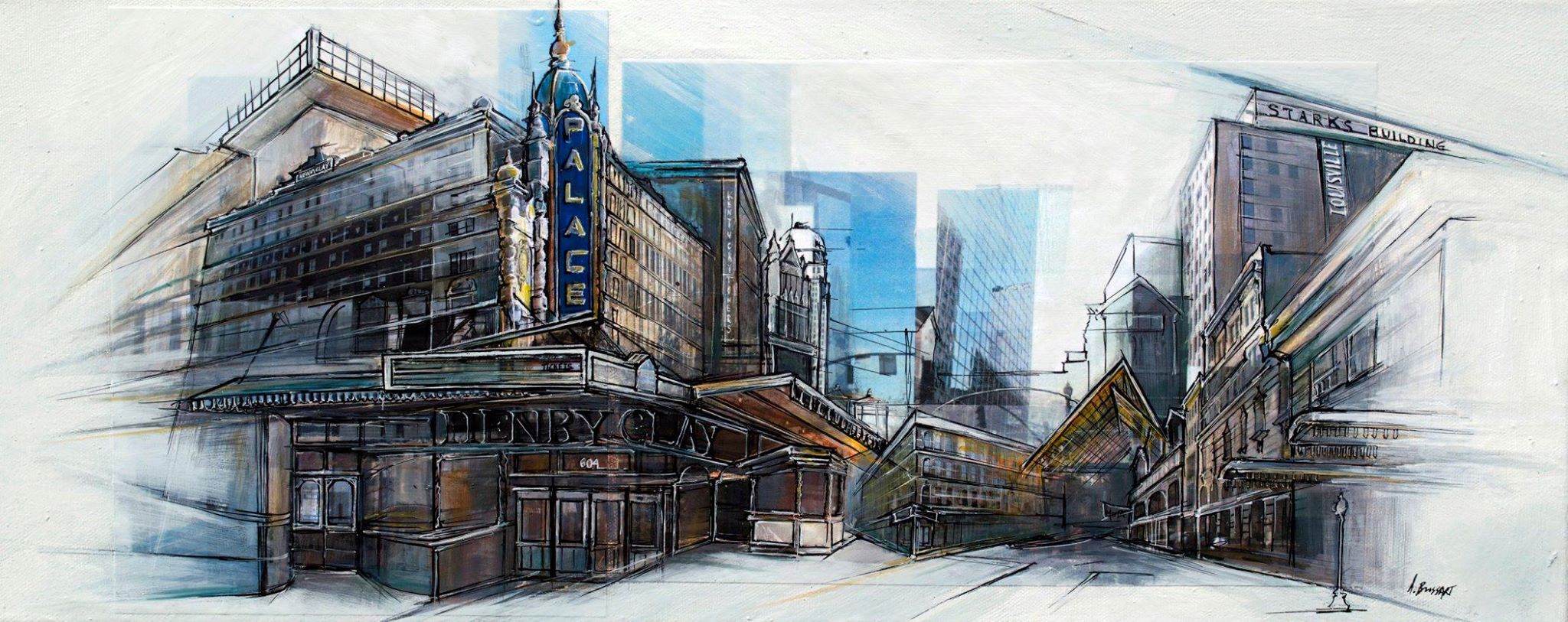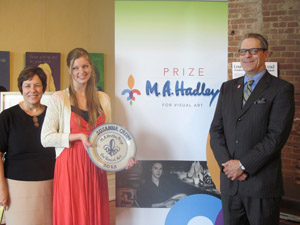Form Not Function: Quilt Art at The Carnegie
Review by Kay Grubola.
Entire contents are copyright © 2019 by Kay Grubola. All rights reserved.
Annual exhibitions can create a dilemma for a museum. They can become too predictable, too comfortable. The Carnegie Museum’s Form Not Function has successfully avoided that problem regularly but this year’s show is especially noteworthy.
In a region with deep roots in quilting, the Carnegie has created a legacy exhibition that honors its roots while consistently urging the art form forward. Different materials and formats are explored in this year’s exhibit including paper and books. The exhibition is full of the expected beautiful surface textures and color but it is much more. These are works full of life and energy and content.

“Pattern Fusion No. 18: Motherboard 9” by Arturo Sandoval Mixed media art quilt, Machine Quilting. 84x97in
That said, do not discount the importance and power of beautiful surfaces in quilts. Many of the pieces have textural surfaces that painters would envy. The subtle layering of various fabrics in Eden Quispe’s work has a timelessness and the transparency of watercolor. Collaging sheer fabrics, lace, beading and employing cutting techniques creates a dream-like quality in the work. Looking at the piece can seem an invasion of privacy… it is a deeply personal internal journey through time.
Arturo Sandoval continues to explore industrial and high-tech materials in spectacular ways with “Pattern Fusion No. 18: Motherboard 9”. He is creating a new vocabulary in textiles which redefines the block patterning of traditional quilts. The visual building blocks of his work come from computer boards, not log cabins. Sandoval’s work has a twenty-first century, three-dimensional sense which distorts space and reflective Holographic surfaces that play with light. Complex and rhythmic they are beautiful to look at but they also leave us pondering questions of industrial waste and of materials which are definitely not biodegradable.
Modern rhythms are also evident in “Anxieties 4: The River Lethe” by Vickie Wheatly and “Curb Appeal” by Margaret Black but rather than industrial they are more of the cool jazz of urban life. You can navigate these pieces the same way you travel through Mondrian’s “Broadway Boogie Woogie” as if excitedly walking the streets of New York.

“Anxieties 4: The River Lethe” by Vickie Wheatley Fiber, Machine Quilting 47x37in
“Memory Loss No 1” by Judy Kirpich was awarded Best in Show and it is an interesting and dramatic choice. Although quilts designated as “art quilts” have broken many bounds they still often employ limited, brightly colored palettes and a clear narrative. Kirpich’s image is brutally expressionistic and contains the angst and darkness of a Susan Rothenberg painting. Large gestural images dyed on the wide expanse of the fabric are punctuated by pieced, graphic, scribbled lines of white, gray and black. It breaks the ties to traditional quilting in many ways while still successfully applying the use of the overall quilt stitching to add to the textural aspects of the work. The impact is visceral. It is a bold statement piece that commands your attention in the gallery.
One other piece in the show had me contemplating the balancing act of new works being created within the discipline of quilting. Although the first reaction of many people to the idea of quilting is one of glorified women’s work or folk art when one truly looks at quilts that notion can be dispelled easily. Quilt designs are rooted in formalism, they clearly emphasize compositional elements such as color, line, shape, texture. So how do you move forward in alternative image making while honoring your traditional quilting roots?
Deborah Hyde has created a work, “Persephone (Jenn)”, that references that formalistic root of traditional quilt composition while altering the space and image-making in the work. She has employed the visual and spatial qualities of formalism while increasing the complexity of the surface to create a more interesting, deeper space. She successfully plays flat pattern off of more sculptural form.
Painstakingly assembled with half inch fabric squares, the traditional Philadelphia Pavement pattern is maintained while at the same time creating a figure on the same plane. It is a work of unquestionably great skill which uses shifts in color masterfully. It is elevated even farther though by the beautiful line quality of the stitching. The figure is enhanced by the gesture of the black thread line that describes the volume and details of the figure. It is a simply beautiful textile piece.
After 15 years of mounting this show, The Carnegie Center continues to expand the conversation on art quilts in a meaningful way. The jurors, Terry Jarrard-Dimond, Dr. Carolyn Mazloomi, and Colleen Merrill, assembled a cohesive and engaging show. I have touched on just a few of the many notable quilts in the exhibit and could easily have held forth on several more. Form Not Function is generally on my “to see” list but this year I especially urge people to experience this exhibition.
The show continues through July 20th but don’t put off your visit, leave yourself time, you may find yourself visiting the gallery more than once.

“New York. Memory Loss No 1” by Judy Kirpich Cotton Textiles, hand & machine quilting 47x80in
2019 Award Winners:
Judy Kirpich, “Memory Loss No. 1”
Suellen Wilkinson Best in Show Award
Presented by Carnegie Center for Art & History, Inc.
Arturo Alonzo Sandoval, “Pattern Fusion No. 18: Motherboard 9”
Award of Excellence Presented by Schmitt Furniture
Kathy Nida, “Womanscape”
Inspired by Nature Award Presented by Juanita Yeager
Emily Bellinger, “Shattered”
Award of Excellence Presented by Louisville Area Fiber and Textile Artists
Margaret Black, “Curb Appeal”
Award of Excellence Presented by River City Fiber Artists
Deborah Hyde, “Persephone”
Award for Creative Use of Stitching Presented by the Southern Indiana Quilt Guild
Maggy Rozycki Hitner, “Perennial”
Honorable Mention
Jeanne Bieri, “Mended Wedding Ring Quilt”
Honorable Mention
Form Not Function: Quilt Art at The Carnegie
May 24-July 20, 2019
The Carnegie Center for Art and History
201 E Spring St
New Albany, Indiana 47150
carnegiecenter.org
Free Admission. Open Monday through Saturday 10:00 AM-5:30 PM
Kay Polson Grubola is an artist and independent curator in Louisville, Kentucky. She has shown her work nationally and internationally. Grubola was the Executive Director of Nazareth Arts, a regional arts center on the campus of the Sisters of Charity of Nazareth in Kentucky, as well as the Artistic Director of the Louisville Visual Art Association. For 10 years she taught drawing and printmaking at Bellarmine University and Indiana University Southeast. As a curator, her exhibits have ranged in subject matter from original concept drawings from the design studios of GM, Chrysler and Ford muscle car era to a nationally recognized extravaganza of handmade dinnerware and exquisite table design, which wowed audiences for more than 20 years.





